
If you’re looking for sensory play ideas for 1-year olds, you’ve come to the right place! In this blog post, we will discuss some fun and stimulating activities that your little one will love.
Sensory play is a great way to help your child learn about their world. It can also help improve their motor skills and cognitive development. So, let’s get started!
What Is Sensory Play?
Sensory play is any activity that engages a child’s senses. This can include activities like playing with sand, water, slime, or sensory balls. It can also involve sensory activities like listening to music, smelling different scents, or exploring textures. Sensory play is important for young children because it helps them learn about their world and develop new skills.
Sensory activities for 1-year-old kids don’t have to be complicated. You just have to let your baby play with different things such as a few old socks, a few different animals, colored construction paper, a few crunchy leaves, a few tubs, and many more! If you let your baby play with these things and more, he or she will have so much fun!
Sensory play is a great way for 1-year-olds to develop their senses. It is also an excellent way for them to have fun! So, what are you waiting for? Go and play with your 1-year old’s senses today!
Why Is Sensory Play Important?
Sensory play is important for several reasons. Let us explore them below:
Sensory play helps babies and toddlers learn about their environment.
One of the advantages of sensory play is that it helps babies and toddlers learn about their environment. When they touch, feel, smell, see, and hear different things, they start to understand more about their surroundings.
For example, if you allow your baby to paint the living room gallery wall or make awesome little homemade gifts using things like leftover plastic easter eggs or a cardboard paper towel roll or two, you are enhancing their fine motor skills and sensory exploration all at once!
Sensory play also supports language development.
When sensory play activities are combined with talking, babies and toddlers learn new words to describe their experiences. For example, if you are playing with a ball together, you can say, “The ball is soft.” or “Look at the red ball.”
It’s important to explore different sensory play ideas with your 1-year old to see what they respond best to. Some babies prefer sensory activities that are visual, while others prefer sensory activities that are tactile.
Sensory play helps develop cognitive skills.
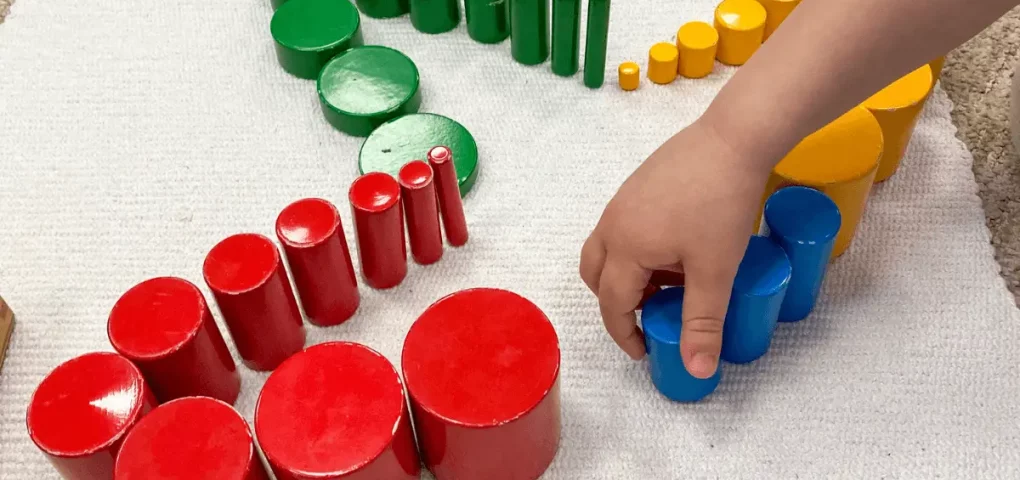
Cognitive skills involve things like problem-solving, reasoning, and cause-and-effect relationships. When sensory play activities are open-ended (meaning there is no one “right” way to do them), babies and toddlers can use their imaginations and experiment with different ways of doing things.
This kind of experimentation is critical for developing cognitive skills. For example, let a baby safely explore squiggly or straight lines by giving him or her mess-free canvas art materials where he or she can draw whatever he or she wants. Mess-free sensory activities exist, but most sensory activities will involve some kind of a mess, and that’s okay!
Sensory play enhances fine motor skills.
In addition, sensory play enhances fine motor skills. When your child handles various objects during sensory play, they strengthen the muscles in their hands and fingers.
Some materials you can use to enhance fine motor skills in 1-year olds include the following:
- empty tissue box to be painted
- vegetable peel play materials
- mini laundry basket to decorate
- toilet paper roll to decorate
- empty cardboard box to explore and decorate
- plastic bag to play with
- inexpensive plastic balls to play with
- food coloring to explore
- a few toys to play around with
- a few rubber bands to play with
- sensory bins to explore
- drop cotton balls to play with
- plastic cups to recycle
You can get so many more materials for just a few bucks. For instance, you can make sensory bins from scratch by just using the materials you already have at home. Therefore, it’s not impossible to encourage sensory play for your baby.
Some Cool Sensory Play Ideas For 1-Year Olds
There are plenty of sensory activities that you can do with your 1-year old. Here are some sensory play ideas to get you started:
DIY ball pit
A DIY ball pit is a great sensory activity for 1-year olds. You can make one by filling a large plastic container with balls. Then, you can add a few toys to the ball pit for your child to play with.
Sensory table
You can also create a sensory table by filling a large plastic container with different materials. For example, you can fill the sensory table with sand, water, rice, beans, or even pasta. Then, you can add some toys to the sensory table for your child to play with.
Water sensory bin
Fill a sensory bin with water and let your 1-year old explore. Add some plastic toys, rubber ducks, and measuring cups for extra fun. These fun things will help your child explore the sensory bin.
Sensory bags
You can make sensory bags by filling a Ziploc bag with different materials. For example, you can fill a sensory bag with shaving cream, sand, rice, or even spaghetti sauce. Then, you can let your 1-year-old squish and squeeze the sensory bag.
Cloud dough
Cloud dough is a soft, fluffy material that’s perfect for molding and sculpting. It’s easy to make at home with just flour and oil. You can place cloud dough in clear plastic containers and keep your baby entertained with it when you need a few minutes to get things done.
Paint with shaving cream
Shaving cream is another great sensory material to use with 1-year-olds. Just squirt some shaving cream onto a plate or tray and let your little one go to town painting with it.
Small plastic container as sensory bin
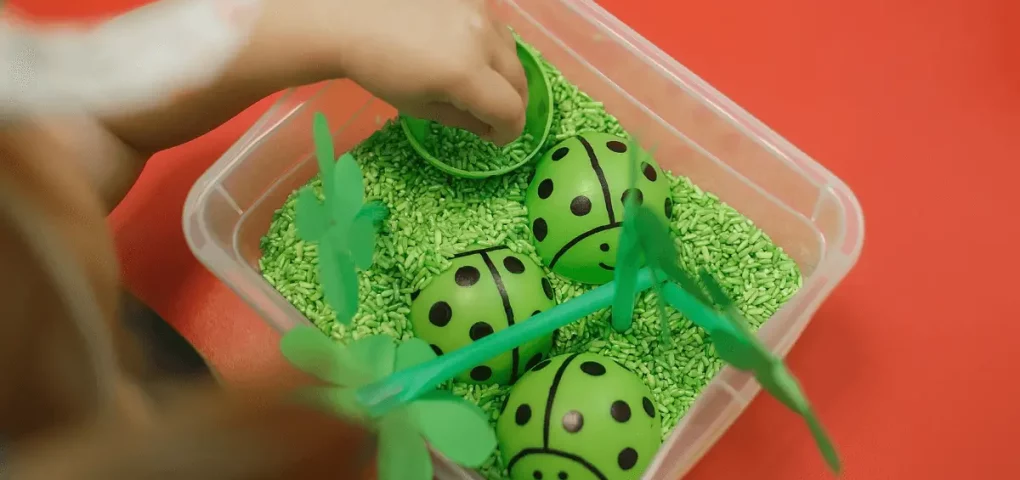
You can also sensory play with a small plastic container. Simply fill the container with water and add some small toys or objects. Your 1-year-old can then explore the sensory bin by scooping up the water and things with their hands.
Encouraging babies to play with sensory materials is a great way to help them develop their fine motor skills.
Sensory bottles
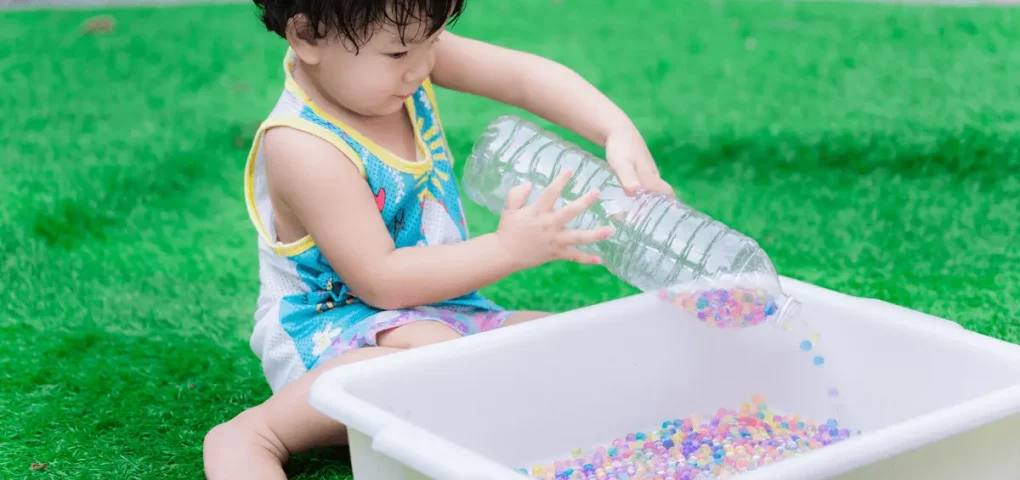
Sensory bottles are easy to make and provide a calming sensory experience for 1-year olds. To make a sensory bottle, fill a small plastic bottle with water and add some glitter, sequins, or other small objects.
You can also add a few drops of food coloring to the water for a fun visual effect. Secure the lid on the bottle and let your 1-year old shake it up and explore the sensory materials inside.
Homemade snow globe art
Homemade snow globes are a fun sensory activity for 1-year olds. To make a snow globe, you will need a small plastic container, water, glitter, and a small figurine. Fill the container with water and add the glitter and figurine. Secure the lid on the container and let your 1-year old shake it up to watch the snow fall.
Little whipped cream art
Whipped cream is a sensory material that 1-year olds will love. To create a sensory activity with whipped cream, simply squirt some whipped cream onto a plate or tray. Your 1-year old can then use their fingers to draw and explore the texture of the whipped cream.
Baby-safe kitchen utensils as toys
One sensory activity that 1-year olds can do is explore different textures with baby-safe kitchen utensils. For this activity, you will need a few other items such as a whisk, wooden spoon, metal spoon, and rubber spatula. Let your 1-year old touch and feel each item to discover the differences in texture.
Touch and feel board
Another sensory activity for 1-year olds is to read touch and feel board books. These books have different textures on each page for your child to explore. Some examples of textures include fur, feathers, sandpaper, and fabric. Touch and feel books are a great way to introduce new textures to your 1-year-old in a safe and fun way.
Sensory rice play
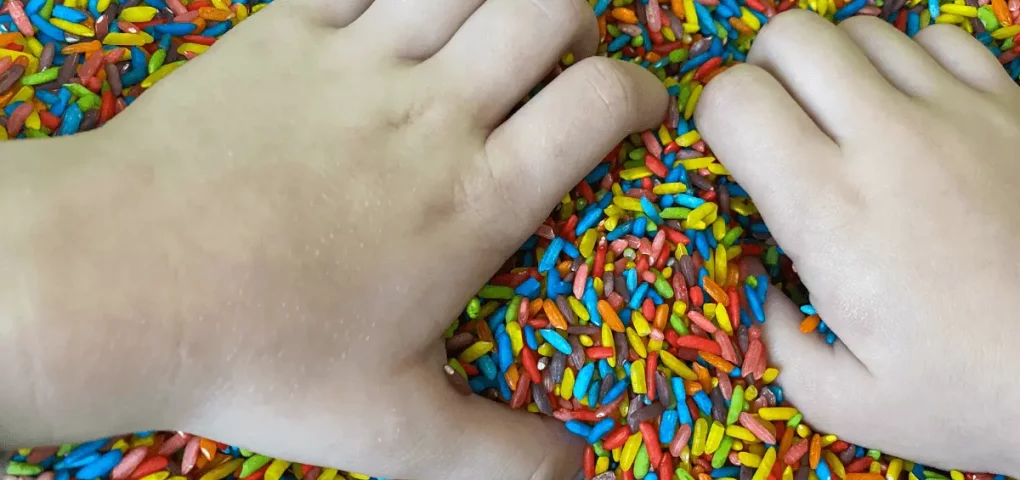
Sensory rice play is a great way to keep your 1-year-old entertained. All you need is a sensory bin and some rice. You can add other items to the sensory bin such as toys, spoons, and cups. Let your 1-year-old explore the sensory bin and discover all the different textures of the rice.
Hand painting
Hand painting is a sensory activity that is perfect for 1-year-olds. All you need is some non-toxic paint and a piece of paper. Put the paint on your 1-year-old’s hands and let them make handprints on the paper. This activity is great for exploring different colors and textures. Let your baby create sensory art with their hands and feet!
Finger painting
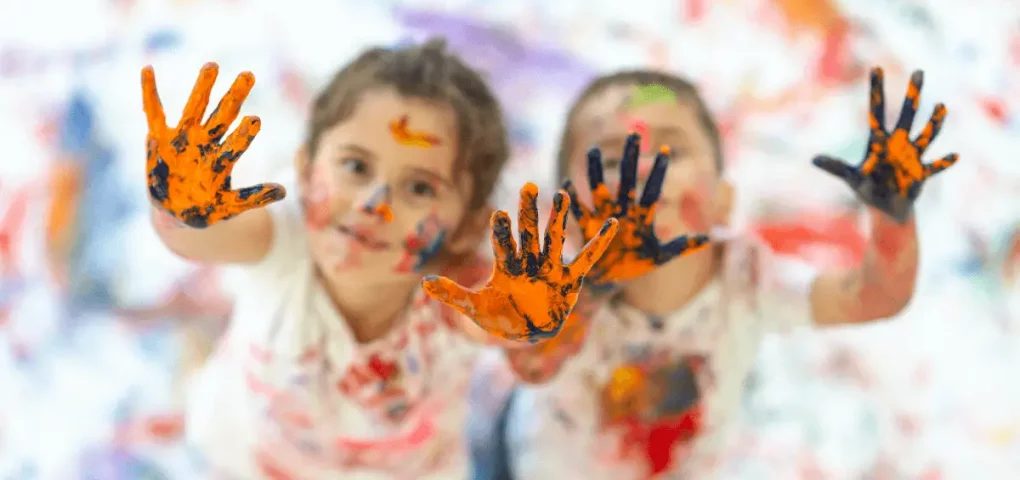
Finger painting is another sensory activity that is perfect for 1-year olds. All you need is some non-toxic paint and a piece of paper. Put the paint on your 1-year-old’s fingers and let them make fingerprints on the paper.
This activity is great for exploring different colors and textures. Let your little one paint pictures if they like! Just make sure to supervise them so that they don’t eat the paint.
Why Are Sensory Activities Perfect for 1-Year Olds?
Sensory activities are perfect for 1-year-olds because they stimulate the senses. These activities can help your child learn about different colors, textures, and shapes. They are also great for promoting fine motor skills and creative expression. So, go ahead and give some of these sensory play ideas a try with your little one!
Is It Expensive To Encourage Sensory Play To My 1-Year Old?
No, sensory play doesn’t have to be expensive. In fact, many sensory activities can be done with items that you already have around the house. For example, you can use rice, beans, or pasta for a sensory bin. Or you can make homemade sensory bags using old socks or balloons.
You can also visit a local craft store and pick up sensory items like pom poms, feathers, or googly eyes. These items can be used to create a sensory board or sensory tray.
Sensory play is a great way to encourage your child’s imagination and creativity. So get started today and see what you can come up with!
How Does Sensory Play Encourage Creativity In My 1-Year-Old?
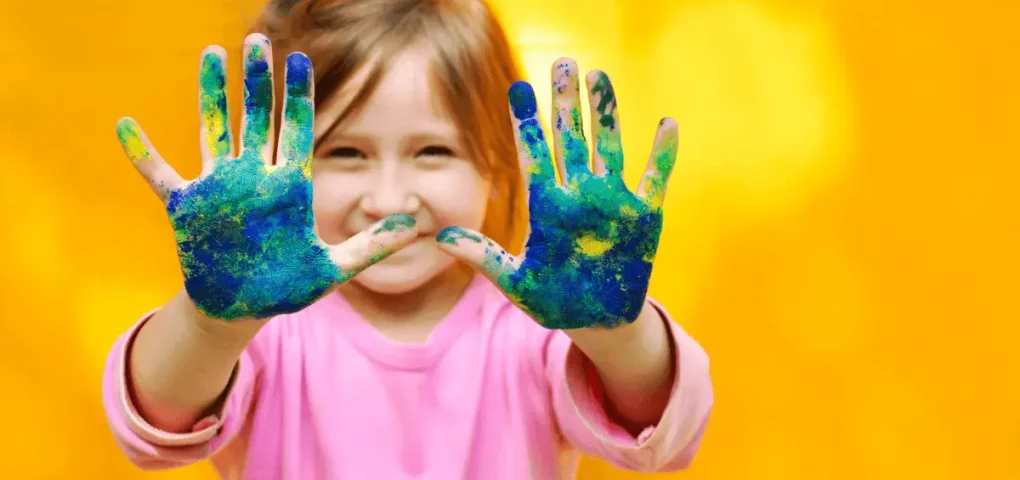
Sensory play is a great way to encourage your child’s imagination and creativity. This is because sensory play helps to stimulate the senses. When the senses are stimulated, it can help your child develop new ideas and thoughts.
Sensory play is also a great way to encourage your child to use their imagination. This is because sensory play can provide your child with an opportunity to create their own world. They can use their imagination to create new things, or they can use their imagination to make believe that they are in a different place.
Sensory play is also a great way to encourage your child’s communication skills. This is because sensory play can help your child to learn how to express themselves through communication. Communication is an important skill for your child to learn, and sensory play can help them to practice this skill.
How Long Should I Let My Child Explore Sensory Play?
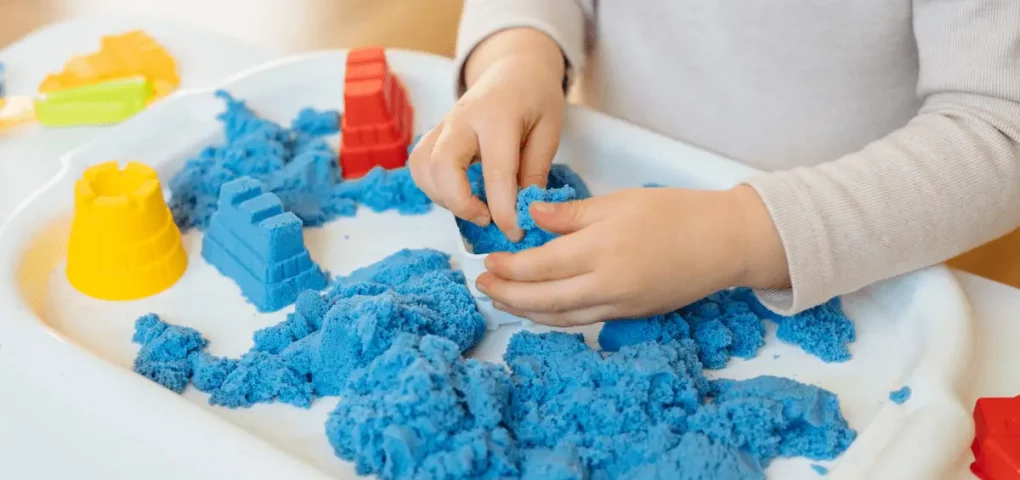
As much as possible, sensory play should be open-ended and flexible. This means that there is no right or wrong way to do sensory play. Your child can explore sensory play for as long as they want, and they can stop when they feel like it.
What Materials Do I Need for Sensory Play?
There are many different materials that you can use for sensory play. Some of the most common materials include:
Sand
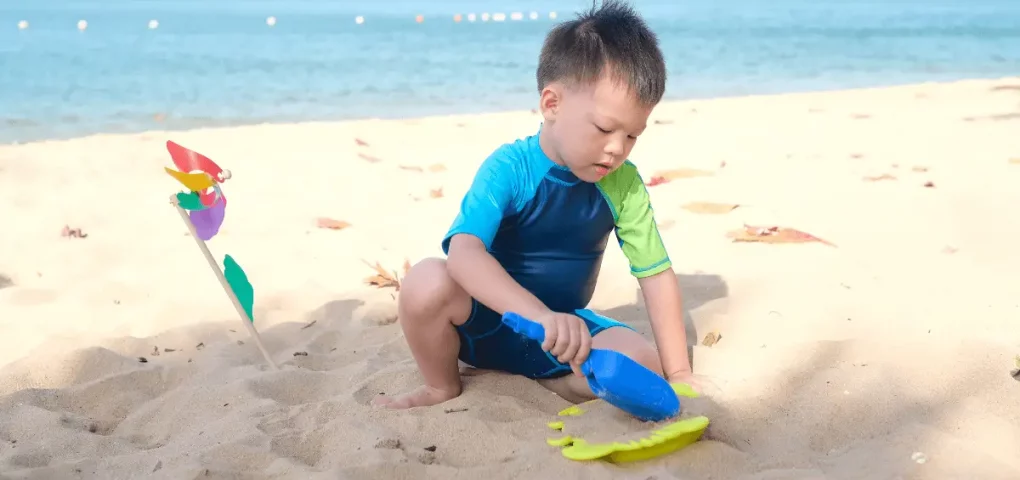
Sand is a great sensory material because it has a unique texture that is both smooth and gritty. It is also easy to mold into different shapes.
Water
Water is another great sensory material because it can be used in many different ways. Your child can splash in the water, pour water, or even just feel the wetness of the water.
Foam
Foam is a great sensory material because it is soft and squishy. It is also easy to mold into different shapes.
Rice
Rice is a great sensory material because it has a unique texture that is both smooth and gritty. It is also easy to mold into different shapes.
Beans
Beans are a great sensory material because they have a unique texture that is both smooth and gritty. They are also easy to mold into different shapes.
Fabric scraps
Fabric scraps are a great sensory material because they are soft and have a variety of textures. They are also easy to mold into different shapes.
Pipe cleaners
Pipe cleaners are a great sensory material because they are flexible and have a variety of textures. They are also easy to mold into different shapes.
Wool
Wool is a great sensory material because it is soft and has a variety of textures. It is also easy to mold into different shapes.
Yarn
Yarn is a great sensory material because it is soft and has a variety of textures. It is also easy to mold into different shapes.
Feathers
Feathers are a great sensory material because they are soft and have a variety of textures. They are also easy to mold into different shapes.
Ribbons
Ribbons are a great sensory material because they are flexible and have a variety of textures. They are also easy to mold into different shapes.
Bells
Bells are a great sensory material because they make a variety of sounds. They are also easy to mold into different shapes.
You can also use household items such as:
- bowls
- cups
- dishes
- pots and pans
- whisk
- measuring cups
- funnels
- sifters
- colanders
Conclusion
Sensory play for kids is a great way to stimulate their senses. It is also a great way to bond with your child. There are many materials that you can use for sensory play. You can use household items such as spoons, bowls, cups, dishes, pots and pans, whisk, measuring cups, funnels, and colanders.
The more you expose your child to sensory activities for 1-year olds, the more they will learn about their senses and the world around them. Sensory play is a great way to stimulate your 1-year old’s senses and bond with them simultaneously. Try using different materials each time you do sensory play to keep things interesting for you and your child.
Parents these days should realize the importance of sensory play for their 1-year olds. After all, sensory play can help the child with fine and gross motor skills, sensory processing, language development, social skills, problem-solving, and more.
There are so many benefits to sensory play that it should be a part of every parent’s repertoire. If you’re unsure where to start, check out the sensory play ideas for 1-year-olds above.


Comments (3)
linasays:
January 4, 2024 at 8:33 pmPersonally I think overjoyed I discovered the blogs.
Albertine206says:
January 8, 2024 at 11:28 amAlways so interesting to visit your site.What a great info, thank you for sharing. this will help me so much in my learning
Ailina206says:
January 9, 2024 at 11:42 pmI think this is an informative post and it is very useful and knowledgeable. therefore, I would like to thank you for the efforts you have made in writing this article.